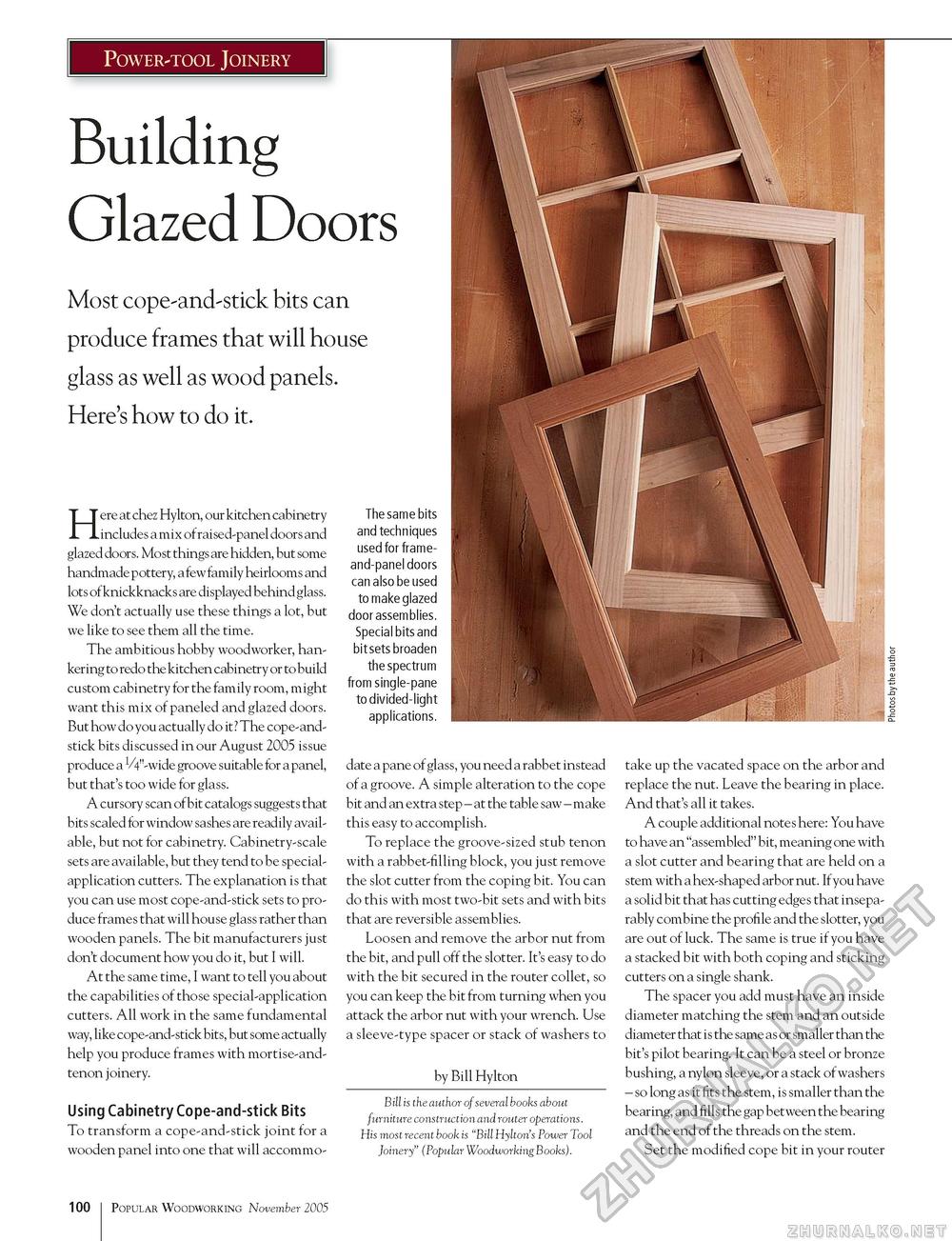Popular Woodworking 2005-11 № 151, страница 103
Power-tool Joinery Building Glazed Doors Most cope-and-stick bits can produce frames that will house glass as well as wood panels. Here's how to do it. Here at chez Hylton, our kitchen cabinetry includes a mix of raised-panel doors and glazed doors. Most things are hidden, but some handmade pottery, a few family heirlooms and lots ofknickknacks are displayed behind glass. We don't actually use these things a lot, but we like to see them all the time. The ambitious hobby woodworker, hankering to redo the kitchen cabinetry or to build custom cabinetry for the family room, might want this mix of paneled and glazed doors. But how do you actually do it? The cope-and-stick bits discussed in our August 2005 issue produce a l"-wide groove suitable for a panel, but that's too wide for glass. A cursory scan ofbit catalogs suggests that bits scaled for window sashes are readily available, but not for cabinetry. Cabinetry-scale sets are available, but they tend to be special-application cutters. The explanation is that you can use most cope-and-stick sets to produce frames that will house glass rather than wooden panels. The bit manufacturers just don't document how you do it, but I will. At the same time, I want to tell you about the capabilities of those special-application cutters. All work in the same fundamental way, like cope-and-stick bits, but some actually help you produce frames with mortise-and-tenon joinery. Using Cabinetry Cope-and-stick Bits To transform a cope-and-stick joint for a wooden panel into one that will accommo- The same bits and techniques used for frame-and-panel doors can also be used to make glazed door assemblies. Special bits and bit sets broaden the spectrum from single-pane to divided-light applications. 1 date a pane of glass, you need a rabbet instead of a groove. A simple alteration to the cope bit and an extra step - at the table saw - make this easy to accomplish. To replace the groove-sized stub tenon with a rabbet-filling block, you just remove the slot cutter from the coping bit. You can do this with most two-bit sets and with bits that are reversible assemblies. Loosen and remove the arbor nut from the bit, and pull off the slotter. It's easy to do with the bit secured in the router collet, so you can keep the bit from turning when you attack the arbor nut with your wrench. Use a sleeve-type spacer or stack of washers to by Bill Hylton Bill is the author of several books about furniture construction and router operations. His most recent book is "Bill Hylton's Power Tool Joinery' (Popular Woodworking Books). take up the vacated space on the arbor and replace the nut. Leave the bearing in place. And that's all it takes. A couple additional notes here: You have to have an "assembled" bit, meaning one with a slot cutter and bearing that are held on a stem with a hex-shaped arbor nut. If you have a solid bit that has cutting edges that inseparably combine the profile and the slotter, you are out of luck. The same is true if you have a stacked bit with both coping and sticking cutters on a single shank. The spacer you add must have an inside diameter matching the stem and an outside diameter that is the same as or smaller than the bit's pilot bearing. It can be a steel or bronze bushing, a nylon sleeve, or a stack of washers - so long as it fits the stem, is smaller than the bearing, and fills the gap between the bearing and the end of the threads on the stem. Set the modified cope bit in your router 100 Popular Woodworking November 2005 |








